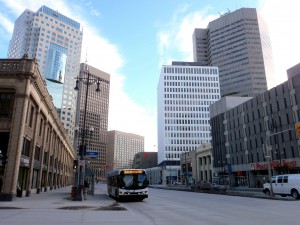One of the stated goals of BRT is that it will revitalize downtown. This is usually just offered as a fact without any backup statements. Because cities with better transit systems often have better downtowns, the argument is that if we spend some money on transit it will make our downtown better. But it is not inevitable that just any transit spending will automatically improve Winnipeg’s core area.
There are two different goals that Winnipeg aims for when trying to revitalize the core area. One is to get more people to come downtown and the other is to get more people to live downtown. It is not clear how the Southwest Corridor will help do either of these things.
The Southwest Corridor will not get more people to come downtown. Those who are going to be connected to downtown via the Southwest Corridor are not going there enough right now when there is ample parking and most of the time it doesn’t take long to drive. If people aren’t going downtown enough by car right now, they’re not going to go by bus.
To revitalize downtown, Winnipeg needs more people coming in the evening hours. An effective transit strategy would be one that keeps buses running frequently later than 6:30 pm. Unfortunately, our current rapid transit buses maintain the same schedule slow-down that used to exist — the one that incentivizes getting out of downtown before 6:30.
Worse, the BRT Corridor currently hits downtown in pretty much the worst place. When once buses ran through bustling Osborne Village on their way to and from the University of Manitoba, they now miss it completely and connect with downtown between railroad tracks and an up-and-coming museum. The museum might be good for tourists, but it’s totally useless for everyday riders. The bus then goes down the most boring part of Main Street – a street that is not scaled for pedestrians at all – turning left two long, horrible walking blocks short of the Exchange District. What about this route will get people taking the bus to go downtown?
The expectation might be that the BRT corridor will be used to leverage development along Main Street, but that will only work if people choose to take that bus. If not enough people are taking the bus right now and not enough people are going downtown, how will a bus corridor to downtown cause people to do either of those things? Which will incentivize which?
So will the BRT Corridor help convince people to live downtown? The answer to that question is the same as this one: Do people who live downtown need a fast bus at rush hour to get to the suburbs?
The answer is no. Downtown residents need to get around downtown. They need buses that move around the core area and act as an augmentation to walking. They need the ability to make short distance trips to an area that already has some retail development and they definitely need to be able to get to a grocery store. If you’re living downtown, a bus is more convenient than a car if it comes often enough and goes to the places you need to get to.
There is, however, a group of people that could potentially live downtown that do need to get out to the suburbs at rush hour: University of Manitoba students. But it is unlikely that the BRT corridor will convince students to live downtown either. New condos going up downtown will likely not be affordable to students. And even if they did live downtown, they will be no better off than they are right now. University of Manitoba students commute in the opposite direction of work commuters. Driving or busing from the core area outward is actually really quick. As a core area resident, I can drive from my house to the perimeter in less than 20 minutes during rush hour. This corridor will have only a minor impact on commute times going to the suburbs. If the corridor doesn’t change current commute times, then it shouldn’t have any impact on how many students are choosing to live downtown.
Revitalizing downtown is an important goal. But like many downtown revitalization mega-projects before it, BRT is not a solution to solving the decay of downtown because it doesn’t confront Winnipeg’s real transit issues..

